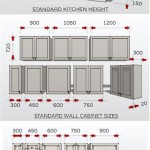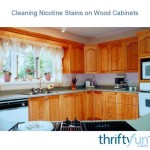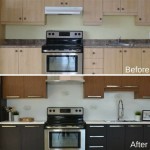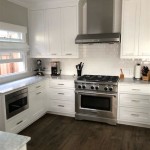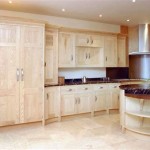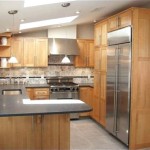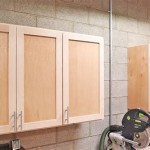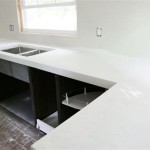Pictures of Dark Colored Kitchen Cabinets: A Comprehensive Exploration
Dark colored kitchen cabinets have experienced a significant resurgence in popularity, offering a sophisticated and dramatic aesthetic to the heart of the home. These cabinets represent a departure from the traditional lighter hues that once dominated kitchen design, creating a space that feels luxurious, modern, and personalized. This article will explore the breadth of dark colored cabinet options, examining their various shades, styles, material considerations, and the design principles that maximize their impact.
The term "dark colored" encompasses a wide spectrum of shades, ranging from deep charcoal grays and inky blues to rich espresso browns and bolder blacks. Each shade evokes a different mood and aesthetic, influencing the overall feel of the kitchen. The selection of the precise dark color necessitates careful consideration of the kitchen's size, natural light availability, and the homeowner's individual style preferences.
The design and implementation of dark colored kitchen cabinets involve numerous factors, including hardware choices, countertop selections, backsplash designs, and flooring options. A cohesive and well-planned approach is crucial to ensuring that the dark cabinets enhance the kitchen's overall design rather than overwhelming it. Careful attention to detail in these supporting elements is essential for achieving a balanced and visually appealing space.
Understanding the Spectrum of Dark Cabinet Colors
Dark colored cabinets are not a monolith; they exist in a variety of shades that offer distinct aesthetic qualities. Each shade can dramatically alter the perceived atmosphere and style of the kitchen. The following outlines some of the most popular dark cabinet colors and their defining characteristics:
Black Cabinets: Black cabinets are a bold statement, often associated with modern and contemporary designs. They can create a sophisticated and dramatic effect, especially when paired with contrasting elements like white countertops or metallic hardware. However, black cabinets can make a small kitchen feel even smaller and darker. Therefore, they are best suited for larger kitchens with ample natural light. The finish of black cabinets plays a critical role: a matte finish can offer a softer, more understated look, while a high-gloss finish can amplify light and add a touch of glamour.
Gray Cabinets: Gray cabinets offer a more versatile alternative to black. Ranging from light charcoal to deep slate, gray cabinets can blend seamlessly with various design styles, from traditional to transitional to modern. Gray is considered a neutral color, allowing for more flexibility in selecting other kitchen elements. Dark gray cabinets can provide a similar dramatic effect as black, while lighter shades of gray can create a more calming and serene atmosphere. The undertones of the gray (warm or cool) should be carefully considered to complement the existing color palette in the kitchen.
Navy Blue Cabinets: Navy blue cabinets offer a touch of color while still maintaining a sense of sophistication and depth. Navy blue is a classic and timeless choice that can evoke a sense of elegance and tranquility. It works particularly well in coastal or traditional style kitchens. The depth of the blue hue can be adjusted to achieve different effects, with darker shades creating a more formal look and lighter shades offering a brighter and more casual feel. Navy blue pairs well with both warm and cool metals, allowing for a wide range of hardware options.
Espresso Brown Cabinets: Espresso brown cabinets provide a warm and inviting alternative to cooler dark colors. They evoke a sense of richness and luxury, often associated with traditional or transitional style kitchens. Espresso brown cabinets can create a cozy and comfortable atmosphere, particularly when combined with natural stone countertops and warm lighting. The depth of the brown hue can vary, with darker shades providing a more dramatic effect and lighter shades offering a more subtle and approachable feel.
Material Considerations for Dark Kitchen Cabinets
The material of the cabinet significantly impacts its durability, aesthetic appeal, and overall cost. Selecting the right material is crucial for ensuring the longevity and visual impact of dark colored kitchen cabinets. Understanding the properties and characteristics of each material is essential for making an informed decision.
Wood Cabinets: Wood remains a popular choice for kitchen cabinets due to its natural beauty, durability, and versatility. Dark stained wood cabinets can offer a rich and sophisticated look, highlighting the natural grain patterns of the wood. Different types of wood will absorb stain differently, resulting in variations in color and texture. Common wood choices for dark stained cabinets include cherry, maple, oak, and walnut. The type of wood chosen will influence the final appearance of the cabinets and their overall cost.
Laminate Cabinets: Laminate cabinets provide a cost-effective alternative to wood. Laminate is a synthetic material that is applied to a substrate, such as particleboard or MDF (medium-density fiberboard). Laminate cabinets are available in a wide range of colors and patterns, including realistic wood grain finishes. They are durable, easy to clean, and resistant to scratches and stains. However, laminate cabinets may not have the same depth of character as real wood and can be more prone to chipping or peeling over time.
MDF Cabinets: MDF is an engineered wood product made from wood fibers and resin. It is a stable and durable material that is less prone to warping or cracking than solid wood. MDF cabinets are often painted rather than stained, providing a smooth and consistent finish. MDF is a good choice for dark painted cabinets as it provides a uniform surface for paint to adhere to. However, MDF is more susceptible to water damage than solid wood and should be properly sealed and maintained.
Metal Cabinets: Metal cabinets offer a sleek and modern look, often used in contemporary or industrial style kitchens. Metal cabinets are durable, fire-resistant, and easy to clean. They can be finished in a variety of dark colors, including black, gray, and stainless steel. Metal cabinets can be more expensive than wood or laminate cabinets, but they offer a unique and durable option for dark colored kitchens.
Design Principles for Maximizing the Impact of Dark Cabinets
The successful implementation of dark colored kitchen cabinets relies on a careful consideration of design principles. Optimizing the interplay of light, color, and materials is crucial for creating a balanced and visually appealing space. Understanding these principles is vital for avoiding common pitfalls and achieving a stunning kitchen design.
Balancing Light and Dark: Dark cabinets can absorb a significant amount of light, making a kitchen feel smaller and darker if not properly addressed. Maximize natural light by incorporating large windows or skylights. Supplement natural light with ample artificial lighting, including recessed lighting, pendant lights, and under-cabinet lighting. Consider using lighter countertops, backsplashes, and flooring to reflect light and create contrast. A well-lit kitchen will prevent dark cabinets from feeling overwhelming and will enhance their visual appeal.
Creating Contrast: Contrast is key to preventing dark cabinets from blending into the background. Use contrasting colors and materials to create visual interest and highlight the features of the cabinets. For example, pairing dark cabinets with white countertops and a light-colored backsplash can create a striking and sophisticated look. Consider using metallic hardware, such as brass or copper, to add warmth and visual interest to the dark cabinets. Incorporating contrasting textures, such as a rough-hewn wood countertop or a textured backsplash, can also enhance the overall design.
Considering the Overall Style: The style of the dark cabinets should complement the overall design of the kitchen. Modern kitchens often feature sleek, frameless cabinets with minimalist hardware. Traditional kitchens may incorporate raised-panel cabinets with ornate details. Transitional kitchens blend elements of both modern and traditional styles. Choose a cabinet style that reflects your personal taste and complements the existing architectural details of your home. A cohesive design will ensure that the dark cabinets enhance the overall aesthetic of the kitchen.
Choosing the Right Hardware: The hardware on dark cabinets can have a significant impact on their overall appearance. Metallic hardware, such as brass, copper, or stainless steel, can add warmth and visual interest to the dark cabinets. Consider the style of the hardware to complement the overall design of the kitchen. Sleek, minimalist hardware is often used in modern kitchens, while ornate hardware is more common in traditional kitchens. Choose hardware that is both functional and aesthetically pleasing. The size and shape of the hardware should be proportionate to the size and style of the cabinets.
Selecting Complementary Countertops: The choice of countertop material and color is crucial for balancing the darkness of the cabinets. Light-colored countertops, such as white quartz or marble, can create a striking contrast and reflect light back into the room. Consider using natural stone countertops, such as granite or soapstone, to add texture and character to the kitchen. Darker countertops, such as black granite or concrete, can create a more dramatic and modern look. The countertop material should be durable, easy to clean, and resistant to stains and scratches. The edge profile of the countertop can also impact the overall design, with squared edges offering a more modern look and rounded edges providing a more traditional feel.
Optimizing Backsplash Design: The backsplash provides an opportunity to add color, texture, and visual interest to the kitchen. Light-colored backsplashes, such as white subway tile or glass mosaic tile, can reflect light and create a sense of spaciousness. Consider using a patterned backsplash to add visual interest and personality to the kitchen. Darker backsplashes, such as black slate or dark gray ceramic tile, can create a more dramatic and modern look. The backsplash material should be durable, easy to clean, and resistant to water damage. The size and shape of the tiles can also impact the overall design, with larger tiles offering a more modern look and smaller tiles providing a more traditional feel.
In conclusion, dark colored kitchen cabinets offer a versatile and stylish design option for homeowners seeking a sophisticated and personalized kitchen space. By understanding the nuances of color selection, material considerations, and design principles, it is possible to create a stunning kitchen that reflects individual style and enhances the overall value of the home. Careful planning and attention to detail are essential for maximizing the impact of dark cabinets and achieving a balanced and visually appealing design.

14 Amazing Color Schemes For Kitchens With Dark Cabinets

Kitchens With Dark Cabinets Kitchen Paint Colors

11 Ideas For Dark Kitchen Cabinets Paintzen

Will A Dark Color Scheme Work For Your Kitchen

Thomasville Casual Deep Green And Brown Kitchen Cabinets

Light Vs Dark Paint Ideas For Your Kitchen Cabinets

Color Schemes For Kitchens With Dark Cabinets Oppolia

11 Ideas For Dark Kitchen Cabinets Paintzen

Everything You Need To Know About Espresso Cabinets Cabinetcorp

13 Stunning Dark Kitchen Cabinet Ideas Family Handyman
Related Posts

